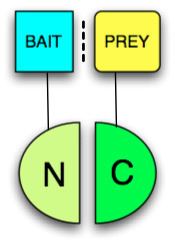 | ||
A Protein-fragment complementation assay, or PCA, is a method for the identification of protein–protein interactions, especially in the field of proteomics. In the PCA, the proteins of interest ("bait" and "prey") are each covalently linked to incomplete fragments of a third protein (e.g. DHFR, which acts as a "reporter"). Interaction between the bait and the prey proteins brings the fragments of the reporter protein in close enough proximity to allow them to form a functional reporter protein whose activity can be measured. This principle can be applied to many different reporter proteins and is also the basis for the yeast two-hybrid system, an archetypical PCA assay.
Split protein assays
Any protein that can be split into two parts and reconstituted non-covalently may be used in a PCA. The two parts just have to be brought together by other interacting proteins fused to them (often called "bait" and "prey" because a bait protein can be used to find a prey protein, see figure). The protein that produces a detectable readout is called "reporter". Usually enzymes which confer resistance to antibiotics, such as Dihydrofolate reductase or Beta-lactamase, or proteins that give colorimetric or fluorescent signals are used as reporters. When fluorescent proteins are reconstituted the PCA is called Bimolecular fluorescence complementation assay. The following proteins have been used in split protein PCAs:
